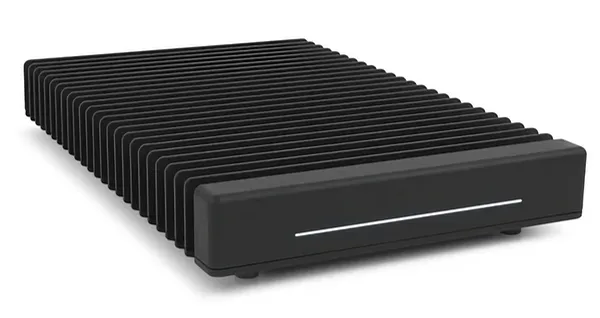 OWC (Other World Computing) is an ancient company in this context, having been founded in 1988. In recent years, OWC carved out a niche in SSD upgrades for the Apple MacBook. Unfortunately, Apple effectively closed this market when it decided to solder on the flash memory chips in all its recent laptops.
OWC (Other World Computing) is an ancient company in this context, having been founded in 1988. In recent years, OWC carved out a niche in SSD upgrades for the Apple MacBook. Unfortunately, Apple effectively closed this market when it decided to solder on the flash memory chips in all its recent laptops.
However, drawing from previous experience, OWC has moved forward with a variety of SSDs in form factors such as PCIe add-in cards, 1.8″ SATA, 2.5″ SATA, and notably high-end external SSDs such as the ThunderBlade.
Features
For an external SSD, the OWC ThunderBlade is not particularly small or lightweight. It’s 7.6″/192 mm long and weighs in at 1.42 lbs/676 g. And it is not made more convenient by the fact that it needs a separate power supply. It comes in a rugged design and also ships with a ‘ballistic’ hard-shell case, which might be suitable considering the high cost of the device.
What’s more interesting from a technical perspective is that the ThunderBlade has dual Thunderbolt 3 ports, which allows for daisy-chaining several ThunderBlade SSDs using OWC’s SoftRAID solution. Using two or more drives in RAID mode will also improve performance considerably.
OWC does not disclose whether the drive’s memory chips are TLC or MLC NAND, or what internal controller is used.
The ThunderBlade SSD is available in capacities 1TB, 2TB, as well as in the high-capacity options 4 TB and even 8 TB.
Performance
According to OWC, this is the fastest SSD of its kind. Internally, the ThunderBlade uses the PCIe 3.0/NVMe interface/protocol but is attached via Thunderbolt 3/USB-C.
Thunderbolt 3 provides up to 40 Gbit/s of bandwidth, so the ThunderBlade will not be limited by the interface, which is frequently the case for other external USB drives. The ThunderBlade offers transfer speeds of up to 2800MB/s read and 2450MB/s write. When using two or more identical drives in OWC’s SoftRAID, read speeds may reach up to 3800MB/s.
A prerequisite to reach maximum performance is of course that the host computer supports Thunderbolt 3 via USB-C.
Warranty and endurance
Unlike most high-end internal SSDs on the market, the OWC ThunderBlade comes with a 3-year warranty instead of the more common five years. There is also no endurance rating in TBW (terabytes written) provided, which is normal for a portable SSD. These terms are similar to what Samsung offers with its X5 SSD.
Reviews
N/A
Full Specifications
OWC ThunderBlade | OWC ThunderBlade X8 | |
|---|---|---|
Interface | 2 x Thunderbolt 3 (40Gb/s) | 2 x Thunderbolt 3 (40Gb/s) |
Drives | 4 x 2280 NVMe M.2 | 8 x 2242 NVMe M.2 |
Capacity | Up to 32TB | Up to 32TB |
RAID Support | RAID 0/1/4/5/1+0 | RAID 0/1/4/5/1+0 |
Maximum RAID 0 Speed | 2831MB/s Write | 2826MB/s Write |
Useable RAID 0 Capacity | 32TB | 32TB |
Maximum RAID 5 Speed | 2120MB/s Write | 2464MB/s Write |
Useable RAID 5 Capacity | 24TB | 28TB |
Cooling | Silent fanless | Silent fanless |
Material | Solid aluminum | Solid aluminum |
Key Differences | Smaller footprint, smaller capacity (4TB) model available | Up to 4TB (16.7%) higher capacity in RAID 4/5. Over 16% higher performance in RAID 4 and 5 redundant configurations with Apple Silicon (all M1 and later including Pro / Max / Ultra) machines, improved power connector, LED angle revised to reduce/eliminate on-set light distraction possibility. |
Was this helpful?
0 / 0